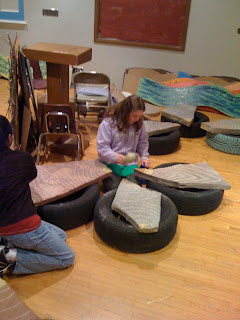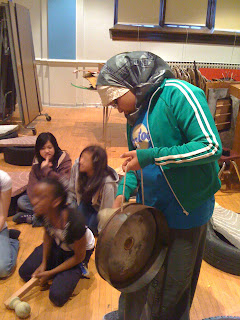Here are two sections of music we played today as we explored different ways of organizing our material.
LISTEN to the Whirlies and Flutes and Balloon Bassoons
LISTEN to Whirlies, Xylophones, Drums, Stones, Gongs and whatnot
This gives us some ideas about what to keep and what to develop in upcoming rehearsals.
Friday, April 25, 2008
Burroughs Tests the Rumble Strip
We tried out some sample shapes and textures for the imminent Rumble Strip.
We then mapped out the structure of the performance so we can play the best sounding combination of instruments and include all the favorite sections we have played before. There's a long way to go in a short time so nailing down the sections and roles will help, then I will play traffic cop/conductor on the day.
We then mapped out the structure of the performance so we can play the best sounding combination of instruments and include all the favorite sections we have played before. There's a long way to go in a short time so nailing down the sections and roles will help, then I will play traffic cop/conductor on the day.
Sunday, April 20, 2008
Burroughs Gongs and Mime
 Working with the rhythms of our names we tried many combinations of patterns on the gongs. In a small room we couldn't do it for long, and the drums and stones are over at Webster.
Working with the rhythms of our names we tried many combinations of patterns on the gongs. In a small room we couldn't do it for long, and the drums and stones are over at Webster.We only have a couple more sessions before the show so we need to bring together all our exercises into a structure that we can present next month.
I can imagine the three gong players processing down the strip as they play.
The class did well with the overlaid nursery rhyme rhythmic patterns last week (when clapping) so that should transfer well to the groups of drums. Maybe they all play the same sequence in unison, or maybe we can organize subgroups to do the multiple layers.



 I was hoping the story we all made a few weeks ago could be easily used as the basis for a mimed drama so we started by cutting up the text line by line and making phonetic sounds based on each person's text.
I was hoping the story we all made a few weeks ago could be easily used as the basis for a mimed drama so we started by cutting up the text line by line and making phonetic sounds based on each person's text.Putting the students in small groups to enact their lines though simply brought out the lurking violence in many of the phrases. The bizarre inventiveness of the language got lost in translation and playground action debased the rest.
The story may still end up in written form on the strip somehow, but if we use any text or action from it, it will only be fragmentary. Perhaps just the names Pooch and Lulu. And I'd like to try movements based on elbows, Pop tarts, macaroni, potatoes and pickles. Maybe a party game where you carry these items in your elbows and pass them around without dropping them...
Webster's Ensemble Takes Shape
 After some heavy lifting (the 12 stones that comprise the Flintstone Gamelan weigh over 700lbs, and the car tires they rest on fill a Range Rover), we have some rocking percussion.
After some heavy lifting (the 12 stones that comprise the Flintstone Gamelan weigh over 700lbs, and the car tires they rest on fill a Range Rover), we have some rocking percussion.Mallets made from finneals with attached handles make perfect strikers. As luck would have it, the stones make a wide tonal range, some would call it a scale. They sound good together anyway.
To control the overall complexity level we will group them in three sets of four stones each; the fewer number of players may yield better rhythmic patterns and interactions.

 Then we did some exercises clapping the rhythms of our first and last names. When applied to three noisy gongs we achieved some terrific cross-pulses and patterns. Vietnamese E De and Philippine Kulintang use gongs a little bit like this, and now we have our tradition.
Then we did some exercises clapping the rhythms of our first and last names. When applied to three noisy gongs we achieved some terrific cross-pulses and patterns. Vietnamese E De and Philippine Kulintang use gongs a little bit like this, and now we have our tradition.



 With the paint dry on our car tires from last week, we started wrapping thm tightly with Scotch 3M sealing tape to make drums. This proved harder than expected; there's a lot of turning and accuracy involved. Not everyone will get a job at UPS... Some drums are really big and they all sound good together.
With the paint dry on our car tires from last week, we started wrapping thm tightly with Scotch 3M sealing tape to make drums. This proved harder than expected; there's a lot of turning and accuracy involved. Not everyone will get a job at UPS... Some drums are really big and they all sound good together.Students who had participated in Sowah Mensah's African Drum class taught the rest of us some African rhythms. With the drums all doing that in unison, we added gongs and stones and made a glorious percussion orchestra. With some traffic direction from Philip (maybe also needed in the performance) we can feel the excitement of what might be.


Sunday, April 13, 2008
Duets and Ensemble Games
 "Sit back to back.
"Sit back to back.Share a hum"
This simple exercise helps you to listen to your partner (if you can), feel the vibrations down your respective spines, and begin a musical dialog. Doing it in many pairs also means you can't tell whose hum you are meant to be sharing, so individual/group dynamics get interesting quickly.
We paired up and played flutes for each other too; this resulted in lively characterful conversations. Maybe we will start the performance like this when the time comes.
We started working on rhythmic games today. We took songs everyone knows (Bah Bah Black Sheep, Twinkle Twinkle Little Star, Hickory Dickory Dock, God Save the Queen) and clapped their rhythms only. Then we divided the groups and tried superimposing one song over another. Eventually we had all four going at the same time. It sounded like we knew what we were doing and proved a quick way to generate complex rhythms. We can easily transfer these skills to the drums when they are ready and people will wonder at the performers' amazing memories.





Painting the Car Tire Taiko Drums
 Painting car tires can be fun and scary; a cool pattern emerges instantly but if you have too much paint it can sink into the cracks and never come out. We tried brushes, pads and eventually brayers (rollers for printmaking).
Painting car tires can be fun and scary; a cool pattern emerges instantly but if you have too much paint it can sink into the cracks and never come out. We tried brushes, pads and eventually brayers (rollers for printmaking). We decided to make giant rubber Froot Loops for the color scheme by having everyone use the primary colors (Red Blue Yellow) and mixing secondary colors to get a rainbow range. This actually made for some fancy textures and will look great from a distance or close up. The idea next week is to wrap these tires tightly with 3M sealing tape to make drums, so this is our only chance for decoration.



Subscribe to:
Posts (Atom)
